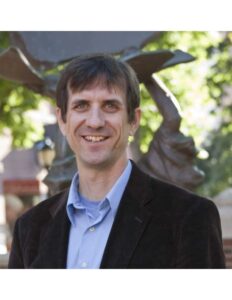
From Invocation to Inquiry: Pedagogical Choices under Constraint
Democracy, in its essence, and genius, is imaginative love for and identification with a community with which, much of the time and in many ways, one may be in profound disagreement. ~ Marilynne Robinson[1]
These words hung like a silent invocation on the threshold of my Truth, Beauty, and Goodness class this fall. They appeared overnight as the election neared, scripted elegantly on a scrap of paper and tucked with intentional inconspicuousness into the door plate of our fifth-floor classroom. Robinson’s words were a sentiment I had shared with students often throughout the past years as we tried to make sense of, well, everything, I guess. I was grateful for the daily reminder—and the “guerilla gardening” of the student who planted these seeds of wisdom in hallways and stairwells around campus.
For weeks, this class of mostly first-year undergraduates checking off their philosophy credits had been carefully cultivating our capacity for dialogue across difference, employing a weekly community of inquiry model to probe issues like kneeling for the national anthem, the removal of statues and monuments, and the place of religion in the public sphere. The weekly community of inquiry was set up with a short, accessible article that provided an example of the theoretical perspectives we were exploring that week. For example, during a week focused on public memory and art, we read a local news article on the removal of a large artistic rendering of a Native American chief that had, for over half a century, looked out over the Mississippi River, just a mile from our campus.
I have attempted versions of communities of inquiry before but not as the primary pedagogical ground for a course. This, however, was a new class in a newly designed major, Ethics, Culture, and Society. And, well, it was 2020. It would be too much to claim that this consistent, student-driven, structured conversation resulted in the airing of all perspectives on an issue, though based on student evaluations, I do think we often approached that Aristotelean “mark of an educated mind”: the ability “to entertain a thought without accepting it.” In so doing, perhaps we bent a little bit further towards Robinson’s generous vision of democracy—if not love for, at least identification with those whom we disagree.
If any class was primed, then, for a post-election conversation on November 4, it was this one. But an hour before class, I balked. Walking into class, I pulled the Robinson scrap (secular mezuzah?) from its perch, read it aloud to the class, paused, read aloud passages from books I had hastily pulled from my shelves—books that had always grounded me and helped me to understand, in the words of Ellen Ott Marshall, “moral agency under constraint.” I told the students we were not going to talk about the election. Instead, I tasked them with finding poems and passages, songs and speeches. We were going to animate our classroom space with the voices of those who help us imagine and bring into being the world we want to live in—in my mind’s eye an attempt, however naïve, at some kind of performative utterance. After ten minutes, students read aloud from their excavations of hope; no commentary, just the words given audible breath.
There would be time and space later for inquiry and dialogue—for example, a letter to the next president expressing their individual hopes for binding up the morally wounded nation, a group project focused on the possibilities of truth and reconciliation processes as response to specific events in the U.S. But for the moment, we needed to be a community of invocation, not inquiry, (re)making our classroom as sacred space insofar as it was set apart from the distorted vocabulary and disordered pathos of our contemporary political discourse—distortion and disorder that make identification with, much less love for, those with whom we disagree an improbability.
Walking out of class that day, like many other days, I wasn’t sure if I had made the right choice. There were no obvious, immediate signs from students. They had participated dutifully, the mood of the class largely subdued—in part, I suspect, because many of these first-time voters had stayed up most of the night watching, waiting for a certainty that has, until recently, remained frustratingly elusive. Later that day, though, I received an email from a student: “I was nervous to come to this class after all the election stuff going on because others are very out there with their opinions and it sometimes freaks me out to talk in the class. So, wanted to say thank you!”
As seems true of most classes, this student had other kindred spirits in the classroom, peers hesitant to make publicly known their perspectives during the semester on a politically fraught topic. But this day in class, many of these same students found their voice for the first time by invoking the words of others, a tentative first step, perhaps, in the movement towards exercising a kind of moral agency under constraint. And this has given me pause to consider the conditions necessary for creating and sustaining a community of inquiry in our classrooms during this tumultuous time. Going forward, one of those conditions in my classroom will be consistently holding open space for students to perform public speech acts that give voice to their perspectives, not merely as imitation, but as invocation.
Notes
[1] Marilynn Robinson, “Imagination and Community,” in When I Was a Child I Read Books (New York: Picador, 2013), 27-28. Also excerpted and reprinted at https://www.commonwealmagazine.org/imagination-community
Leave a Reply